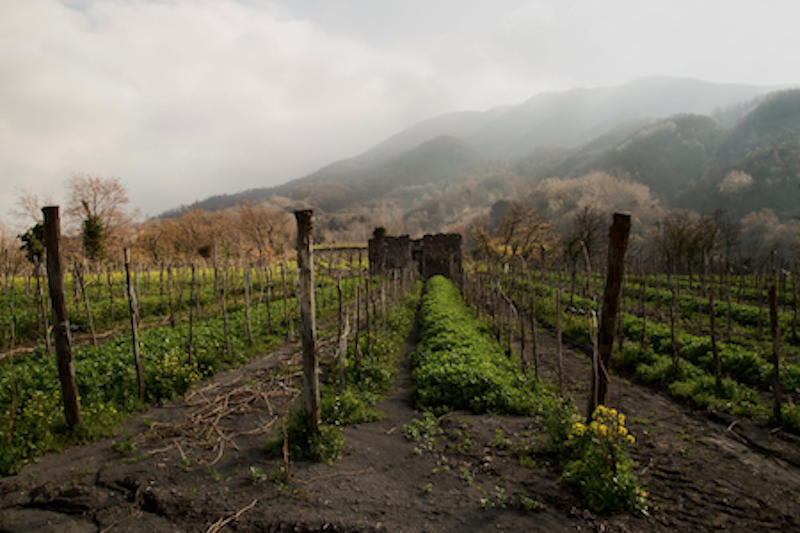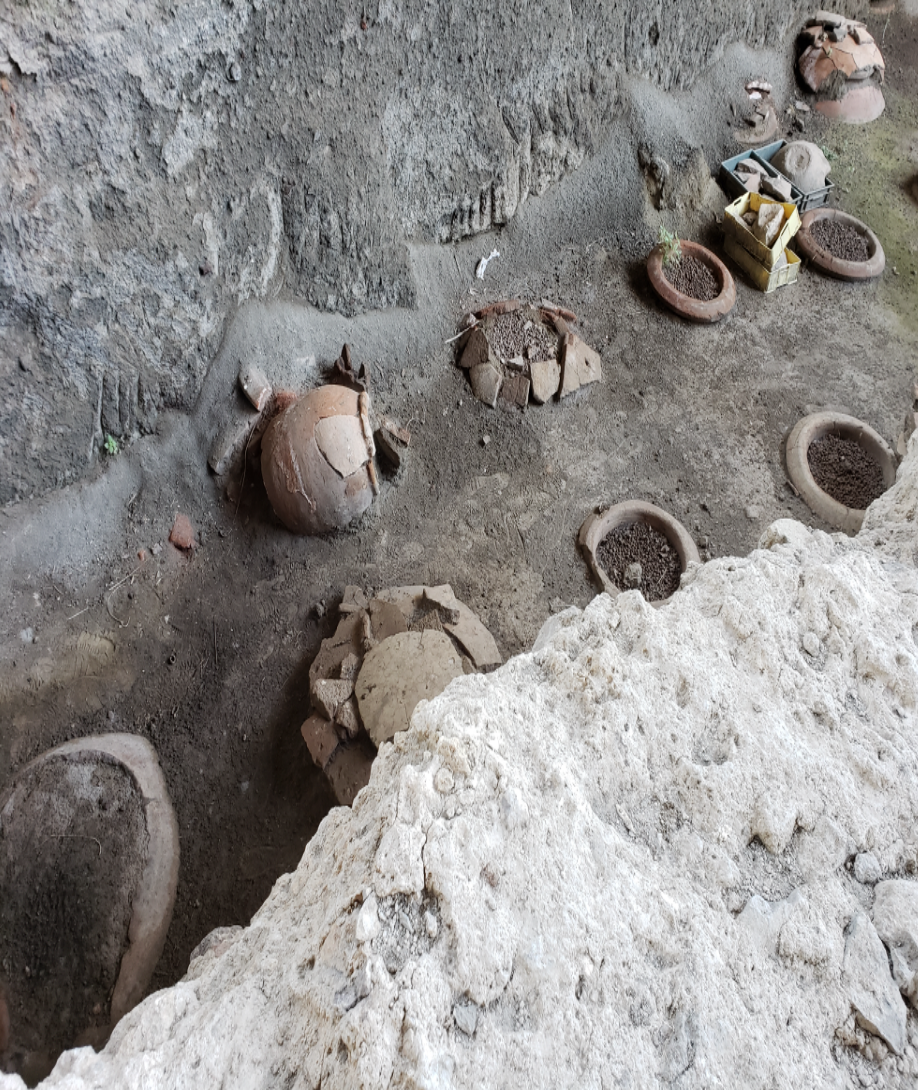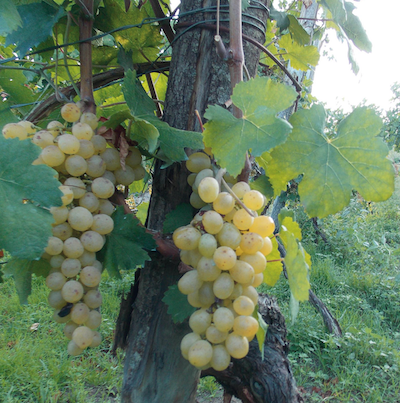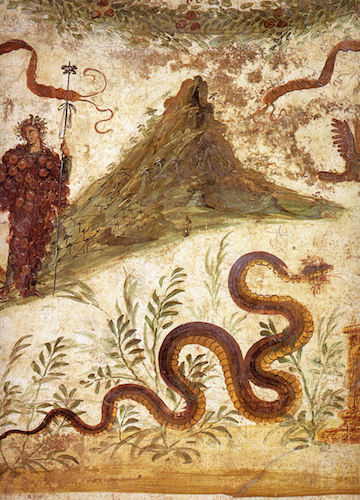
Vesuvio, also known as Mount Vesuvius, is home to wines of explosive flavor and historical controversy. Vesuvio’s legendary eruption of 79 AD destroyed the wealthy, coastal towns of Pompeii and Herculaneum, though vines and enological tradition remained rooted.
In the early part of this first millenia, Vesuvio was home to one of Italy’s largest wine production centers.  Villa Augustea, found at the skirt of Mount Somma, was the meeting-place for pagan farmers. Carriages of communal grapes were brought into the hall to be ceremoniously stomped by feet and then laid to rest and age in dolios, amphora clay vessels. Dolios of Vesuvio wine have been found in the northern parts of Africa and even parts of India.
Villa Augustea, found at the skirt of Mount Somma, was the meeting-place for pagan farmers. Carriages of communal grapes were brought into the hall to be ceremoniously stomped by feet and then laid to rest and age in dolios, amphora clay vessels. Dolios of Vesuvio wine have been found in the northern parts of Africa and even parts of India.
(Photo, left: Remnants of dolios found in Vesuvio)
Pagans don't mess around -- folks in those times literally worshipped wine. Despite paganism culture being outlawed by Romans at the time of Villa Augustea's operation, prayer services paid tribute to Dionysus, thanking the God of Wine for that year's harvest and wine. Dionysus was like a pagan vigneron's Buddha, Mohammed, Jesus, you name it. Wine represented vitality and even mere existence for pagan farmers from Vesuvio.
Vesuvio wine production eventually expanded beyond the countryside and became prized throughout Europe and the known wine world. But of course, as is the case with so many rich wine regions in the world, sometimes the bright lights of human innovation turn off.
Yet there is always the possibility of turning the lights back on. Ciro Giordano, current president of the Vesuvio Wine Protection Consortium, is leading the charge in inspiring a reawakening among Vesuvian producers -- n ot through prayer to “Wine Jesus”, but rather from good old fashioned hard work! Work like, reestablishing traditional winemaking techniques, native grapes, and historic terroirs. In addition to wine, Ciro loves other Vesuvio delights, such as napoletana pizza with Piennolo DOP cherry tomatoes and typical “poor man’s baccala” reinvented to name a few.
ot through prayer to “Wine Jesus”, but rather from good old fashioned hard work! Work like, reestablishing traditional winemaking techniques, native grapes, and historic terroirs. In addition to wine, Ciro loves other Vesuvio delights, such as napoletana pizza with Piennolo DOP cherry tomatoes and typical “poor man’s baccala” reinvented to name a few.
Ciro's winery, Cantine Olivella, is located in Sant'Anastasia region of Mount Somma. Ciro's wine is made from recovered varietals such as Catalanesca, Caprettone, and Piedirosso. Once meeting Ciro you quickly realize his insane work ethic, and with every passing step he is swift and steadfast. Soon enough, he will bring Vesuvio back to its rightful summit in the wine world.
--
Grape Collective visited Ciro at his winery Cantine Olivella in September of 2018.
Marco Salerno: What does the winery’s name, icon and saying "SEXCATI FESTI" mean?
 Ciro Giordano: The winery Cantine Olivella is in Sant'Anastasia, or "at the foot of the mountain", as an ancient etymology suggests, in the heart of the Vesuvius National Park, a protected area that is the ideal habitat for vine cultivation.
Ciro Giordano: The winery Cantine Olivella is in Sant'Anastasia, or "at the foot of the mountain", as an ancient etymology suggests, in the heart of the Vesuvius National Park, a protected area that is the ideal habitat for vine cultivation.
(Photo, left: Ciro Giordano of Cantine Olivella)
The winery has been recovered and revitalized in order to protect our ancient tradition and history of winemaking. In fact, at the foot of Mount Somma, an ancient cantina was was discovered in 1974. This ancient cantina helped produce some of the finest wines of ancient Rome. At this ancient cantina, a terra cotta container, “dolio”, beared the saying "Sextus Catius Festus", coupled with a stamp depicting a stylized leaf, similar to a little heart. This artifact’s seal has significantly become the very logo of the "Cantine Olivella". The name of the company derives from an ancient "Olivella" spring located on Mount Somma, which supplied water to the Palazzo Reale di Carlo di Borbone in Portici.
The company today has 12 hectares of vineyards divided into three different municipalities: Sant'Anastasia, Pollena Trocchia and Somma Vesuviana, located between 300 and 650 m above sea level.
The management of the vineyards pursues the maximum biological balance: green manure and fertilization only where they are needed; balanced pruning; treatments using products with low environmental impact; manual management of all the most delicate operations, including the harvesting of the grapes. We at Cantine Olivella carry forward an agriculture aware of traditions but ready for innovation, and our goal is to make a good wine a good story.
How do you guys - Andrea Cozzolino, Ciro Giordano and Domenico Ceriello - come together to found Cantine Olivella?
1993 was a decisive year, when I met Domenico and Andrea. We started to restore an old vineyard of Catalanesca grapes, grown for generations by Andrea's family. Logistic work and the first winemaking tests were carried out. The theater: a basement, an old press and a steel tank that replaced the numerous demijohns. It was necessary to transform the "farmer's wine" into a wine that could compete with those of the most important wineries.
In 2002, to test the knowledge on the subject I wrote to the late Luigi Veronelli, who in those years was considered the greatest expert in the world of wine. I asked him, pretending to be an unsuspecting consumer, where could I find and taste Catalanesca wine. To my surprise, he answered me, writing:
"Dear Domenico, you have only one real way to get to know Catalanesca, a wine with great impact on civil society, going to the most beautiful of the Italian Osterias ... With a warm heart" -Luigi Veronelli
He went on to mention the name and address of an inn that made the Catalanesca wine “for friends”. Perhaps we were on the right track. To draw more attention to the Catalanesca grape, in the following years we organized and participated in numerous conferences, together with local producers, experts in the sector, journalists and various institutions. In 2004 "Cantine Olivella" was born. Andrea and Domenico joined Ciro, and also Andrea's nephew, who gives the winery new energy, great professionalism and technical expertise.
 Today we are the fourth generation of winemakers, with the good fortune to cultivate our vines on a volcanic-sandy soil ideal for growing vines using the propagation technique for offshoots, traditionally called "pass annanz".
Today we are the fourth generation of winemakers, with the good fortune to cultivate our vines on a volcanic-sandy soil ideal for growing vines using the propagation technique for offshoots, traditionally called "pass annanz".
(Photo, right: Pass ananz in the vineyard of Cantine Olivella, photo courtesy of Lucianopignatro.it)
In 2006, the Catalanesca was registered in the catalog of grapes suitable for vinification and recommended for the municipalities of the province of Naples. In October of the same year the Cantine Olivella produced the first officially recognized Catalanesca wine.
In 2011, the Indicazione Geografica Tipica (IGT, today, IGP, ie Indicazione Geografica Protetta) covered "Catalanesca del Monte Somma", as stated in the regulations, from white Catalanesca grapes (minimum 85%) is approved and from suitable vines in the production area and produced in the two types Bianco (dry) and Passito. The territory includes nine municipalities that are on the slopes of Mount Somma (San Sebastiano, Massa di Somma, Cercola, Pollena Trocchia, Sant'Anastasia, Somma Vesuviana, Ottaviano, San Giuseppe Vesuviano and Terzigno).
This territory, besides being always the area of choice for this vine, is also part of the local tradition and culture, as well as bio-environmental and historical heritage. It is therefore no coincidence that the legendary Catalanesca is our grape.
Catalanesca is an important grape for your winery. Please tell us her story.
The grape in question is historically cultivated on Mount Somma, but the origin is Catalan, as Catalanesca is the mythical name of the vine: a unique case.
 According to the Gaudio (1990), the grape was introduced in the countryside of Somma by Alfonso I of Aragon during the fifteenth century. Catalanesca was gradually spread throughout the Vesuvian land at various heights between 150 and 600 meters, where it was possible a late ripening and good preservation, so much was exported to Europe.
According to the Gaudio (1990), the grape was introduced in the countryside of Somma by Alfonso I of Aragon during the fifteenth century. Catalanesca was gradually spread throughout the Vesuvian land at various heights between 150 and 600 meters, where it was possible a late ripening and good preservation, so much was exported to Europe.
(Photo, left: Catalanesca grapes)
For many years, it was registered by ampelography as table grapes and therefore vinifying was not allowed, despite the fact that local farmers, aware of its qualities, had always used it to make wine.
Catalanesca became more appreciated with the studies conducted by Luigi Moio and Michele Manzo, who declared it "a grape with all attitudes to be vinified", in the 1990s. But only in 2006 was it officially registered in the list of wine grapes and from 2011 it was permitted to be put on the market with the long-awaited and coveted name "Catalanesca del Monte Somma IGT". The soils that characterize the territory of Monte Somma, the residual part of the original "Somma Vesuvio", are extremely rich in minerals, a characteristic that gives the grapes a very particular connotation.
Catalanesca is a late harvesting variety, which is harvested during the first half of October. It was an ancient custom to harvest the clusters until the Christmas period. In the dry white version, the wine is typically of a beautiful straw yellow with the golden reflections, with intense aromas of apricot, intense minerality, both on the nose and on the palate. It needs to be aged in the bottle to be appreciated at best.
What about Caprettone? It is not a grape to forget about. Tell us her story too.
Caprettone, a very vigorous vine with a rather curious name, probably referring to the shape of the vine cluster, similar to the goat's beard, or to the shepherds who undertook its cultivation.
Caprettone represents white Vesuvio wine. In fact, the DOC recognizes 85% Caprettone and 15% by Falanghina and Greco as Lacrima di Christi Bianco, or 100% Caprettone for Vesuvio Caprettone DOP.
On the slopes of Vesuvius, Caprettone is usually the first vine to be harvested. With its pale straw-yellow color, it has delicate aromas of mulberry and apricot. Discreet softness, strong minerality and good structure are the main aspects that characterize it. It is elegant and is amplified with food pairings, such as sea salad, “octopus in casserole”, Italian wedding soup, white meats and vegetable soups. Ideal with Somma Vesuviana cod.
Caprettone has a large, five-lobed leaf, of a light green color, large clusters of pyramidal shape, a small and regular berry, a thick yellowish and pruinose skin. It has good productivity but it is not very vigorous, it ripens on average in the second fortnight of September.
It expresses through the passion and stubbornness of all three partners, Andrea Cozzolino, Ciro Giordano and Domenico Ceriello, who together commit to daily research of a constantly evolving Caprettone excellence. Cantine Olivella was founded in 2004, but the winemaking tradition is more dated. Andrea's family, already in the '60s, cultivated on its own and vinified for friends and local restaurateurs.
Today, 50,000 bottles are produced into six different types. Among them there is Emblema, 100% Caprettone, matured in steel tanks at controlled temperature and refined "sur lie" in steel for three months. Caprettone offers the sensation of a reached and precocious balance that should allow, over the years, also a discrete preservability.
Caprettone is very versatile; as an aperitif or throughout the meal, with fresh cheeses, raw seafood or main course meals. In short, perfect for every occasion.
Please tell us the history of vinification in Vesuvius.
"Sacred and ancient wine has the mysterious color of hellfire, the taste of lava, lapilli, ash that buried Herculaneum and Pompeii"
With these words, the writer and journalist from Prato, Curzio Malaparte, tried to explain the irresistible charm of one of the most prized wines of Campania, born from the the most famous active volcano in the West: Lacryma Christi del Vesuvio.
To learn the origins of this wine, it is necessary to relive the ancient myths, without trying to separate the myth from reality because only fused together can perpetuate the magic of a wine and the earth from which it arose.
Legend has it that Lucifer, the angel chased out of the Kingdom of Heaven, fell to the underworld and tore a strip of paradise to make the gulf of Naples. In the process, he created a chasm of chaos from which Vesuvius would then be generated; Jesus, realizing what had happened, poured out his tears of pain on the volcano, making the lands fertile and vines rose from there.
Yet another mythical version of the facts claims that, instead, the wine would have originated when Jesus was on one of his many pilgrimages around the world. Before leaving, he pretended to be thirsty to test the generosity of the man who, having shown himself willing to share his water with a stranger, saw the water transform into excellent wine as a sign of gratitude.
The slopes of Vesuvius, as it is known, were home to a large number of rustic villas.
Some of the villas found have a structured morphology based on on the production of wine, serving as further evidence of the spread of this cultivation.
 The presence of the God of wine in the frescoes of the House of the Centenary in Pompeii, where he is immortalized while he is presiding over the slopes of Vesuvius, testifies the diffusion of this type of drink and its copious production in the current Neapolitan province. Bacchus is engraved in many other Roman artistic productions saved by the 79 AD eruption.
The presence of the God of wine in the frescoes of the House of the Centenary in Pompeii, where he is immortalized while he is presiding over the slopes of Vesuvius, testifies the diffusion of this type of drink and its copious production in the current Neapolitan province. Bacchus is engraved in many other Roman artistic productions saved by the 79 AD eruption.
(Pictured, left: A painting in the House of the Centenary depicts the earliest known representation of Vesuvius)
Currently, the Lacryma Christi del Vesuvio continues to inebriate the population of the Vesuvian territory with its full-bodied taste and has received the DOC name only in 1983 despite its centuries-old history. Wine is produced with native grapes in 15 municipalities in the province of Naples belonging to the Vesuvius National Park, an area devoted to viticulture. The most widespread varieties are Caprettone and Coda di Volpe, minimum 85% used for Lacryma Christi Bianco and other white grape varieties recommended for the province of Naples and Piedirosso used for Lacryma Christi Rosé and Rosso, minimum 85% and Aglianico.
Ciro is the president of Vesuvio. What is its role and what does it hope to do?
The Vesuvio Wine Protection Consortium was born on 07/26/2007. Today, the consortium has almost 114 members, divided between winemakers, winemakers and bottlers.
Decree that has given the Consortium the task to perform the functions of protection, enhancement and supervision of general care for the interests connected to the protected designation of Vesuvius origin.
The Vesuvio Wine Protection Consortium wants to play a decisive role in expanding knowledge and demand, through the protection and enhancement of D.O.P. wines. In concrete terms, the Consortium wants to dedicate itself to the development of brand policies, operating through the strategic tools of the care of general interests, of valorisation and protection.
Recently, the Consorzio Tutela Vini Vesuvio participated in the fifty-second edition of the 'Vinitaly', the international exhibition of wines and spirits scheduled in Verona. In Verona, the Consortium Vesuvius aimed to catalyze the attention on the strong issues that emerged during the first conference on volcanic wines, held in New York, "Volcanic Wines". In New York, we thought about the path to be taken to recognize the wines produced in the volcanic regions as high quality productions. Our territory’s biodiversity is a driving force in order to distinguish the Vesuvian wine to the world.










